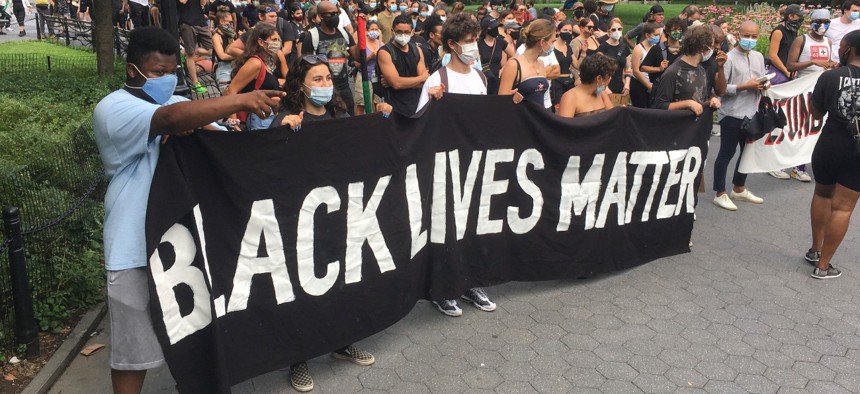Federal Employees May Wear or Display Black Lives Matter Paraphernalia at Work
The Office of Special Counsel released guidance on how the Hatch Act applies to the movement.
Federal employees are permitted to wear or display Black Lives Matter paraphernalia in the workplace, as it is not an “inherently partisan” movement, according to the independent agency that oversees the Hatch Act prohibiting civil servants from participating in political activity while on the job.
The Office of Special Counsel released updated guidance on Wednesday on how the Hatch Act applies to the Black Lives Matter movement, as first reported by Federal News Network. The movement started in 2013 and has gained renewed prominence in the wake of nationwide protests for racial justice after police in Minneapolis killed George Floyd in May.
“BLM is a ‘hot-button’ issue and both politically and culturally salient,” OSC said. “But BLM terminology is issue-based, not a campaign slogan. Therefore, using BLM terminology, without more, is not political activity... and employees are not prohibited from wearing or displaying [Black Lives Matter Global Network] paraphernalia in the workplace.”
During the 2016 presidential election cycle, BLM met with candidates from both political parties, but ultimately decided to not endorse any candidate, OSC noted. Now during the 2020 cycle, the organization is focused on increasing voter registration and educating voters on police brutality, racial injustice, health care, the environment, education and other issues, said the memo.
OSC said this situation is similar to the Tea Party movement that started in 2009 to advocate for lower taxes and government spending in response to the Obama administration's policies. Like BLM, the Tea Party was “a leaderless movement that apparently arose in response to social concern,” the agency stated.
The first version of the guidance went out last Friday, but OSC sent an updated version on Wednesday to note it only applies to the Hatch Act and not “other laws, rules, or regulations that may apply to expressions of support for, or opposition to, BLM while on duty or in the workplace.” The office recommended employees ask their agencies’ ethics officials if they have any further questions.
In addition to wearing and displaying BLM paraphernalia, federal employees may participate in the protests and donate money to related causes as long as they are off duty, wrote Sarah Martin, attorney at Kalijarvi, Chuzi, Newman & Fitch, P.C. and member of the Board of Directors for the Metropolitan Washington Employment Lawyers Association, in Government Executive in June.
Although some agencies are starting to bring employees back into offices, many are still teleworking due to the ongoing pandemic. OSC released guidance in May on how the Hatch Act still applies while working from home through social media, video conferencing and other technology.




